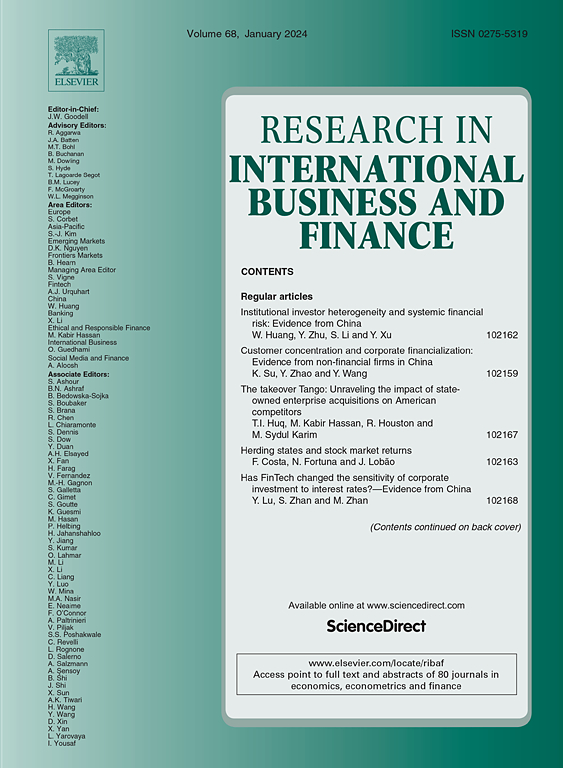银行业对欧盟 CRD IV 法规的市场反应
IF 6.9
2区 经济学
Q1 BUSINESS, FINANCE
Research in International Business and Finance
Pub Date : 2024-11-10
DOI:10.1016/j.ribaf.2024.102652
引用次数: 0
摘要
本文旨在为欧盟银行业对欧盟 CRD IV 监管公告的市场反应提供证据,并从银行和国家层面研究其决定因素。欧盟 CRD IV 于 2008 年金融危机后出台,被认为是欧洲层面提高银行整体透明度的最显著监管举措。通过对 2011 年至 2013 年间的 15 项公告进行事件研究,我们记录了 145 家欧洲上市银行样本的负面市场反应,表明透明度的提高由股东承担,对银行股价产生了不利影响。我们的研究结果表明,投资者对这一法规的引入持负面看法,对于位于主权债务风险较高国家的透明度较低、大型且复杂的银行,投资者的反应更为明显。我们的研究结果为有关银行透明度问题的讨论做出了贡献。本文章由计算机程序翻译,如有差异,请以英文原文为准。
Market reaction to EU CRD IV regulation in the banking industry
This paper aims to provide evidence on the market reaction to the EU CRD IV regulation announcements in the EU banking industry and examine their determinants at the bank and country levels. EU CRD IV came up in the aftermath of the 2008 financial crisis, and it is recognized as the most notable regulatory initiative at the European level to increase overall bank transparency. Employing an event study approach around 15 announcements between 2011 and 2013, we document a negative market reaction on a sample of 145 listed European banks, indicating that transparency increases are borne by shareholders, with detrimental impacts on bank stock prices. We show that investors negatively perceive the introduction of this regulation, with more pronounced reactions for poorly transparent, large, and complex banks located in countries with high exposure to sovereign indebtedness. Our findings contribute to the debate on bank transparency matters.
求助全文
通过发布文献求助,成功后即可免费获取论文全文。
去求助
来源期刊

Research in International Business and Finance
BUSINESS, FINANCE-
CiteScore
11.20
自引率
9.20%
发文量
240
期刊介绍:
Research in International Business and Finance (RIBAF) seeks to consolidate its position as a premier scholarly vehicle of academic finance. The Journal publishes high quality, insightful, well-written papers that explore current and new issues in international finance. Papers that foster dialogue, innovation, and intellectual risk-taking in financial studies; as well as shed light on the interaction between finance and broader societal concerns are particularly appreciated. The Journal welcomes submissions that seek to expand the boundaries of academic finance and otherwise challenge the discipline. Papers studying finance using a variety of methodologies; as well as interdisciplinary studies will be considered for publication. Papers that examine topical issues using extensive international data sets are welcome. Single-country studies can also be considered for publication provided that they develop novel methodological and theoretical approaches or fall within the Journal''s priority themes. It is especially important that single-country studies communicate to the reader why the particular chosen country is especially relevant to the issue being investigated. [...] The scope of topics that are most interesting to RIBAF readers include the following: -Financial markets and institutions -Financial practices and sustainability -The impact of national culture on finance -The impact of formal and informal institutions on finance -Privatizations, public financing, and nonprofit issues in finance -Interdisciplinary financial studies -Finance and international development -International financial crises and regulation -Financialization studies -International financial integration and architecture -Behavioral aspects in finance -Consumer finance -Methodologies and conceptualization issues related to finance
 求助内容:
求助内容: 应助结果提醒方式:
应助结果提醒方式:


